light Lexus ES300h 2018 (OM33D45U) User Guide
[x] Cancel search | Manufacturer: LEXUS, Model Year: 2018, Model line: ES300h, Model: Lexus ES300h 2018Pages: 608, PDF Size: 10.67 MB
Page 30 of 608
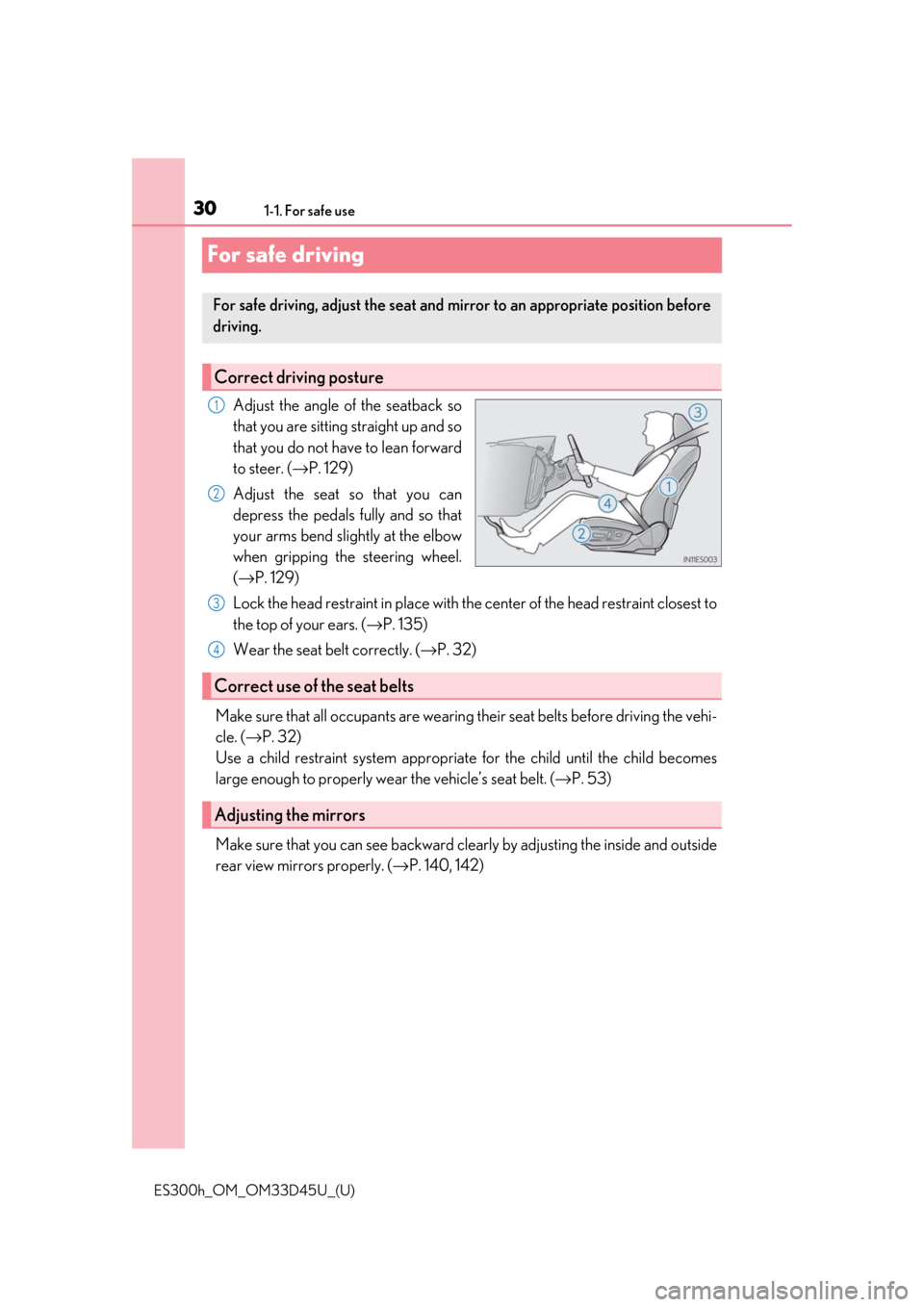
301-1. For safe use
ES300h_OM_OM33D45U_(U)
For safe driving
Adjust the angle of the seatback so
that you are sitting straight up and so
that you do not have to lean forward
to steer. (→P. 129)
Adjust the seat so that you can
depress the pedals fully and so that
your arms bend slightly at the elbow
when gripping the steering wheel.
(→ P. 129)
Lock the head restraint in place with th e center of the head restraint closest to
the top of your ears. ( →P. 135)
Wear the seat belt correctly. ( →P. 32)
Make sure that all occupants are wearing their seat belts before driving the vehi-
cle. ( →P. 32)
Use a child restraint system appropriate for the child until the child becomes
large enough to properly wear the vehicle’s seat belt. ( →P. 53)
Make sure that you can see backward clearly by adjusting the inside and outside
rear view mirrors properly. ( →P. 140, 142)
For safe driving, adjust the seat and mirror to an appropriate position before
driving.
Correct driving posture
1
2
Correct use of the seat belts
Adjusting the mirrors
3
4
Page 33 of 608
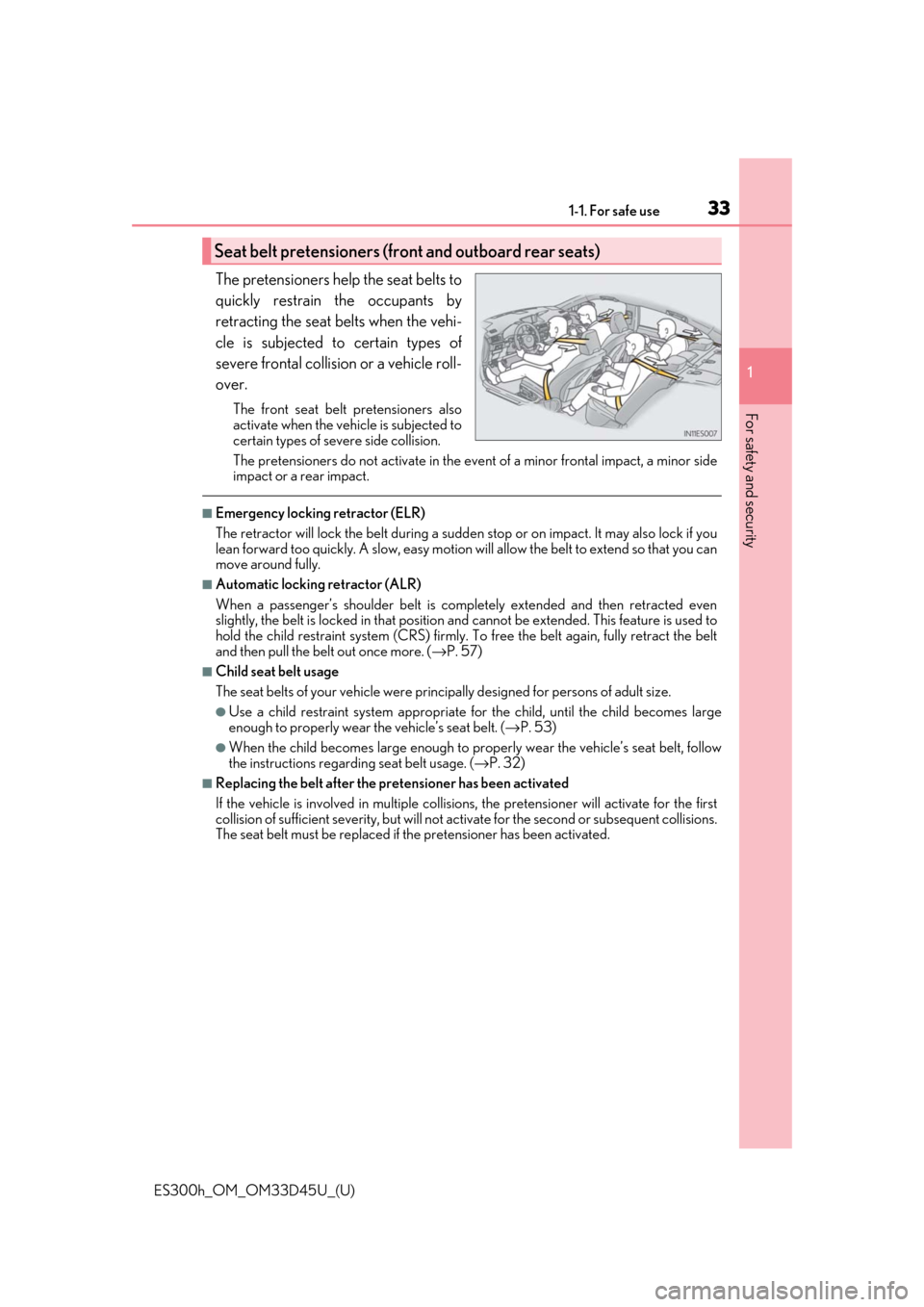
331-1. For safe use
ES300h_OM_OM33D45U_(U)
1
For safety and security
The pretensioners help the seat belts to
quickly restrain the occupants by
retracting the seat belts when the vehi-
cle is subjected to certain types of
severe frontal collision or a vehicle roll-
over.
The front seat belt pretensioners also
activate when the vehicle is subjected to
certain types of severe side collision.
The pretensioners do not activate in the ev ent of a minor frontal impact, a minor side
impact or a rear impact.
■Emergency locking retractor (ELR)
The retractor will lock th e belt during a sudden stop or on impact. It may also lock if you
lean forward too quickly. A slow, easy motion w ill allow the belt to extend so that you can
move around fully.
■Automatic locking retractor (ALR)
When a passenger’s shoulder belt is completely extended and then retracted even
slightly, the belt is locked in that position and cannot be extended. This feature is used to
hold the child restraint system (CRS) firmly. To free the belt again, fully retract the belt
and then pull the belt out once more. ( →P. 57)
■Child seat belt usage
The seat belts of your vehicle were principally designed for persons of adult size.
●Use a child restraint system appropriate fo r the child, until the child becomes large
enough to properly wear the vehicle’s seat belt. ( →P. 53)
●When the child becomes large enough to properly wear the vehicle’s seat belt, follow
the instructions regardin g seat belt usage. (→P. 32)
■Replacing the belt after the pr etensioner has been activated
If the vehicle is involved in multiple collisions, the pretensioner will activate for the first
collision of sufficient severity, but will not ac tivate for the second or subsequent collisions.
The seat belt must be replaced if the pretensioner has been activated.
Seat belt pretensioners (front and outboard rear seats)
Page 35 of 608
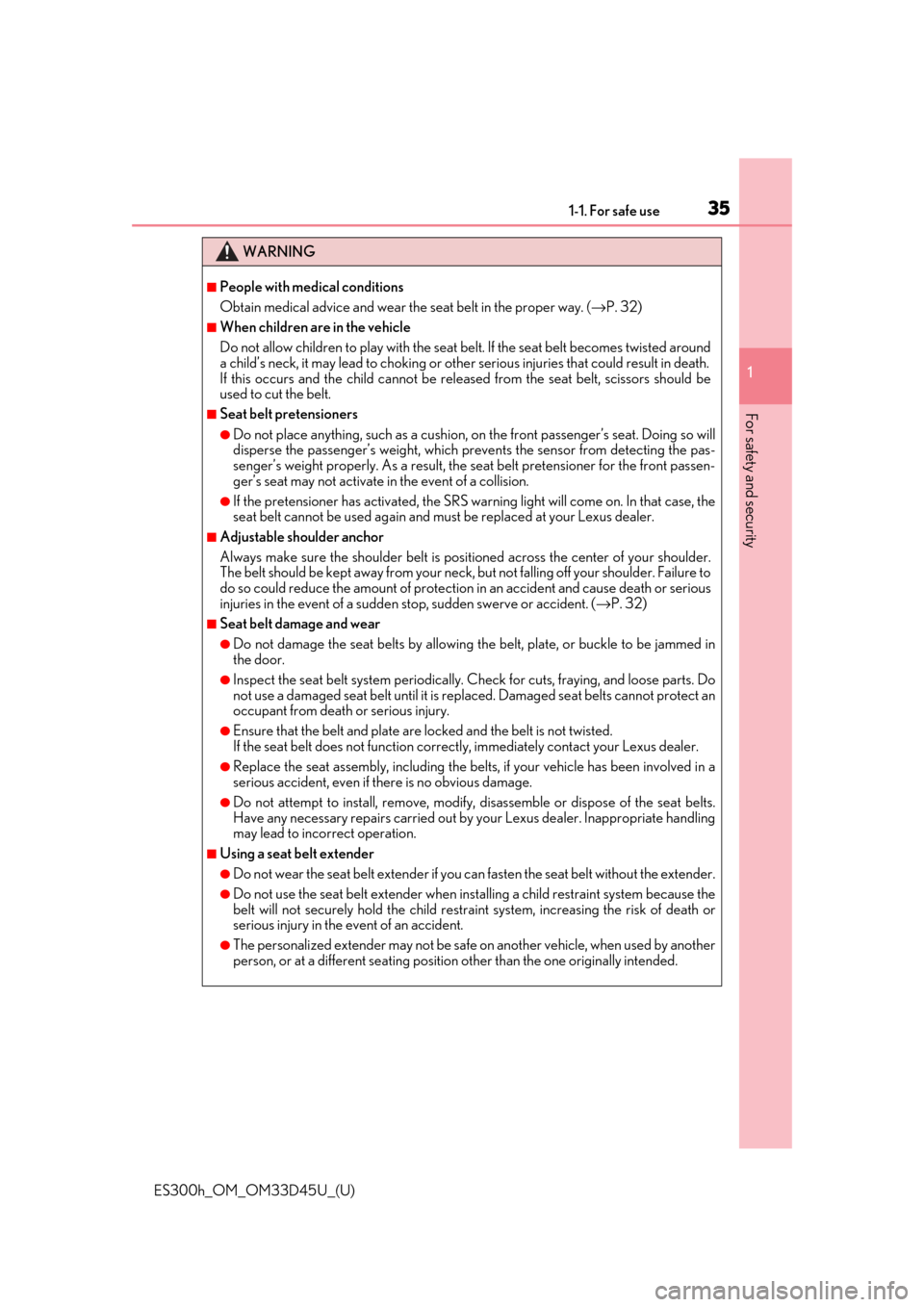
351-1. For safe use
ES300h_OM_OM33D45U_(U)
1
For safety and security
WARNING
■People with medical conditions
Obtain medical advice and wear the seat belt in the proper way. (→P. 32)
■When children are in the vehicle
Do not allow children to play with the seat belt. If the seat belt becomes twisted around
a child’s neck, it may lead to choking or othe r serious injuries that could result in death.
If this occurs and the child cannot be releas ed from the seat belt, scissors should be
used to cut the belt.
■Seat belt pretensioners
●Do not place anything, such as a cushion, on the front passenger’s seat. Doing so will
disperse the passenger’s weight, which prevents the sensor from detecting the pas-
senger’s weight properly. As a result, the seat belt pretensioner for the front passen-
ger’s seat may not activate in the event of a collision.
●If the pretensioner has activated, the SRS wa rning light will come on. In that case, the
seat belt cannot be used again and must be replaced at your Lexus dealer.
■Adjustable shoulder anchor
Always make sure the shoulder belt is posi tioned across the center of your shoulder.
The belt should be kept away from your neck , but not falling off your shoulder. Failure to
do so could reduce the amount of protection in an accident and cause death or serious
injuries in the event of a sudden stop, sudden swerve or accident. ( →P. 32)
■Seat belt damage and wear
●Do not damage the seat belts by allowing th e belt, plate, or buckle to be jammed in
the door.
●Inspect the seat belt system periodically. Check for cuts, fraying, and loose parts. Do
not use a damaged seat belt until it is replaced. Damaged seat belts cannot protect an
occupant from death or serious injury.
●Ensure that the belt and plate are locked and the belt is not twisted.
If the seat belt does not function correct ly, immediately contact your Lexus dealer.
●Replace the seat assembly, including the belts, if your vehicle has been involved in a
serious accident, even if there is no obvious damage.
●Do not attempt to install, remove, modify, disassemble or dispose of the seat belts.
Have any necessary repairs carried out by your Lexus dealer. Inappropriate handling
may lead to inco rrect operation.
■Using a seat belt extender
●Do not wear the seat belt extender if you can fasten the seat belt without the extender.
●Do not use the seat belt extender when in stalling a child restraint system because the
belt will not securely hold the child restra int system, increasing the risk of death or
serious injury in the event of an accident.
●The personalized extender may not be safe on another vehicle, when used by another
person, or at a different seating position other than the one originally intended.
Page 38 of 608
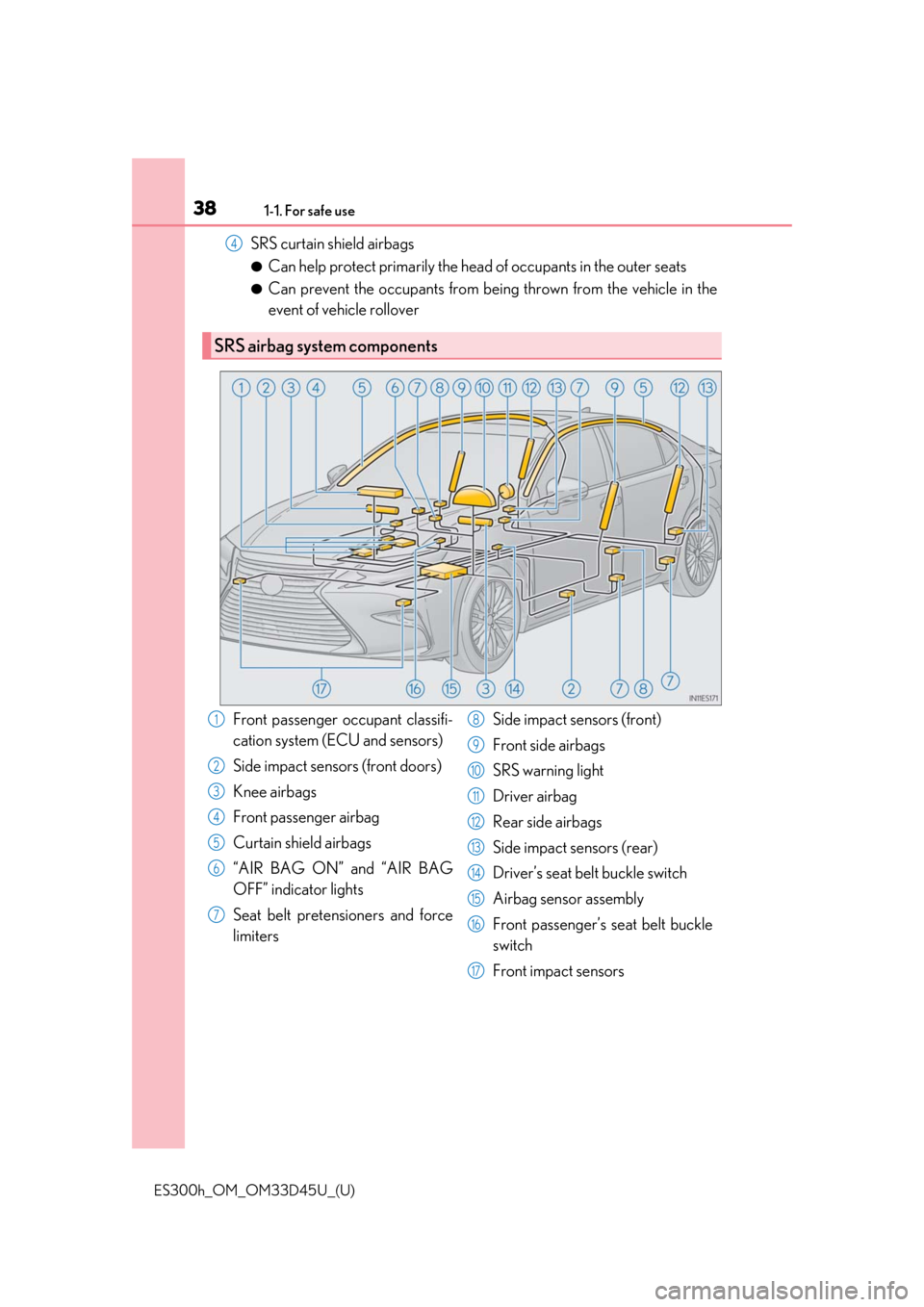
381-1. For safe use
ES300h_OM_OM33D45U_(U)
SRS curtain shield airbags
●Can help protect primarily the head of occupants in the outer seats
●Can prevent the occupants from being thrown from the vehicle in the
event of vehicle rollover
SRS airbag system components
4
Front passenger occupant classifi-
cation system (ECU and sensors)
Side impact sensors (front doors)
Knee airbags
Front passenger airbag
Curtain shield airbags
“AIR BAG ON” and “AIR BAG
OFF” indicator lights
Seat belt pretensioners and force
limiters Side impact sensors (front)
Front side airbags
SRS warning light
Driver airbag
Rear side airbags
Side impact sensors (rear)
Driver’s seat belt buckle switch
Airbag sensor assembly
Front passenger’s seat belt buckle
switch
Front impact sensors1
2
3
4
5
6
7
8
9
10
11
12
13
14
15
16
17
Page 39 of 608
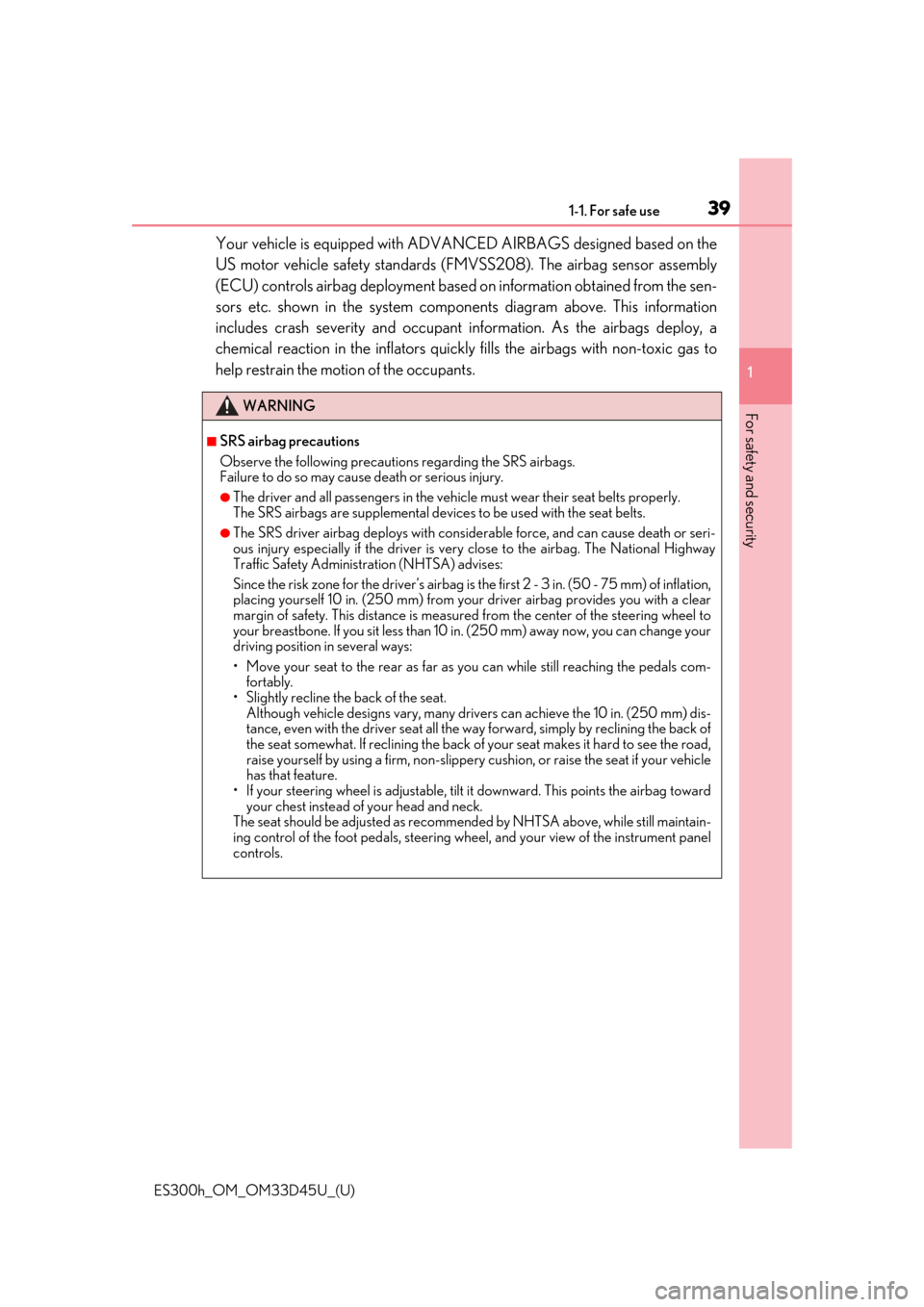
391-1. For safe use
ES300h_OM_OM33D45U_(U)
1
For safety and security
Your vehicle is equipped with ADVA NCED AIRBAGS designed based on the
US motor vehicle safety standards (F MVSS208). The airbag sensor assembly
(ECU) controls airbag deployment based on information obtained from the sen-
sors etc. shown in the system compon ents diagram above. This information
includes crash severity and occupant information. As the airbags deploy, a
chemical reaction in the inflators quickly fills the airbags with non-toxic gas to
help restrain the motion of the occupants.
WARNING
■SRS airbag precautions
Observe the following precaution s regarding the SRS airbags.
Failure to do so may cause death or serious injury.
●The driver and all passengers in the vehicle must wear their seat belts properly.
The SRS airbags are supplemental devices to be us ed with the seat belts.
●The SRS driver airbag deploys with considerable force, and can cause death or seri-
ous injury especially if the driver is very close to the airbag. The National Highway
Traffic Safety Administration (NHTSA) advises:
Since the risk zone for the driver’s airbag is the first 2 - 3 in. (50 - 75 mm) of inflation,
placing yourself 10 in. (250 mm) from your driver airbag provides you with a clear
margin of safety. This distance is measured from the center of the steering wheel to
your breastbone. If you sit less than 10 in . (250 mm) away now, you can change your
driving position in several ways:
• Move your seat to the rear as far as you can while still reaching the pedals com-
fortably.
• Slightly recline the back of the seat. Although vehicle designs vary, many drivers can achieve the 10 in. (250 mm) dis-
tance, even with the driver seat all the wa y forward, simply by reclining the back of
the seat somewhat. If reclining the back of your seat makes it hard to see the road,
raise yourself by using a firm , non-slippery cushion, or raise the seat if your vehicle
has that feature.
• If your steering wheel is ad justable, tilt it downward. This points the airbag toward
your chest instead of your head and neck.
The seat should be adjusted as recommended by NHTSA ab ove, while still maintain-
ing control of the foot pedals, steering whee l, and your view of the instrument panel
controls.
Page 42 of 608
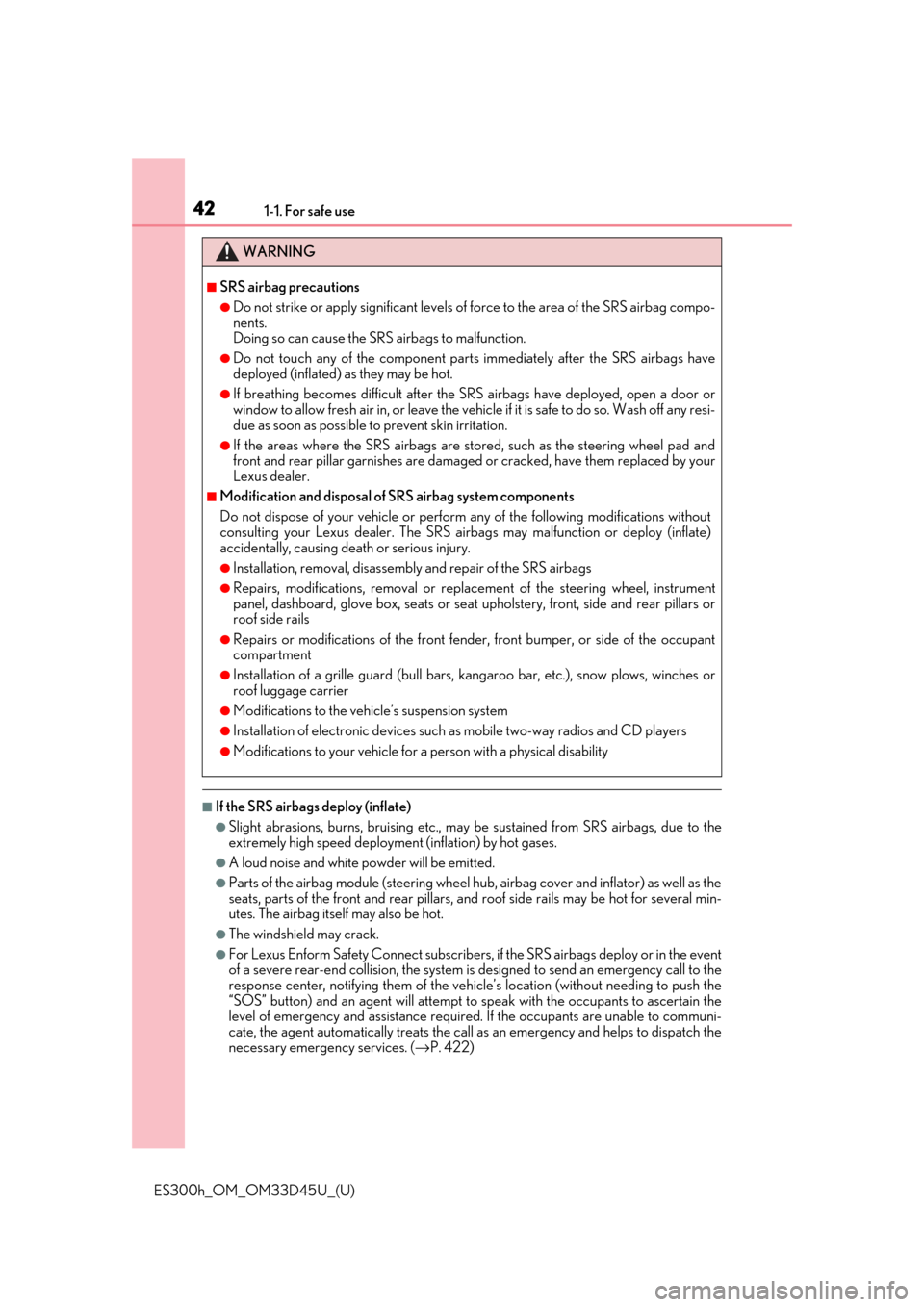
421-1. For safe use
ES300h_OM_OM33D45U_(U)
■If the SRS airbags deploy (inflate)
●Slight abrasions, burns, bruising etc., may be sustained from SRS airbags, due to the
extremely high speed deployment (inflation) by hot gases.
●A loud noise and white powder will be emitted.
●Parts of the airbag module (steering wheel hub, airbag cover and inflator) as well as the
seats, parts of the front and rear pillars, an d roof side rails may be hot for several min-
utes. The airbag itself may also be hot.
●The windshield may crack.
●For Lexus Enform Safety Connect subscribers, if the SRS airbags deploy or in the event
of a severe rear-end collision, the system is designed to send an emergency call to the
response center, notifying them of the vehicle’s location (without needing to push the
“SOS” button) and an agent will attempt to speak with the occupants to ascertain the
level of emergency and assistance required . If the occupants are unable to communi-
cate, the agent automatically treats the call as an emergency and helps to dispatch the
necessary emergency services. ( →P. 422)
WARNING
■SRS airbag precautions
●Do not strike or apply signif icant levels of force to the area of the SRS airbag compo-
nents.
Doing so can cause the SRS airbags to malfunction.
●Do not touch any of the component part s immediately after the SRS airbags have
deployed (inflated) as they may be hot.
●If breathing becomes difficult after the SR S airbags have deployed, open a door or
window to allow fresh air in, or leave the vehicl e if it is safe to do so. Wash off any resi-
due as soon as possible to prevent skin irritation.
●If the areas where the SRS airbags are stored, such as the steering wheel pad and
front and rear pillar garnishes are damaged or cracked, have them replaced by your
Lexus dealer.
■Modification and disposal of SRS airbag system components
Do not dispose of your vehicle or perform any of the following modifications without
consulting your Lexus dealer. The SRS airb ags may malfunction or deploy (inflate)
accidentally, causing death or serious injury.
●Installation, removal, disassembly and repair of the SRS airbags
●Repairs, modifications, removal or replacement of the steering wheel, instrument
panel, dashboard, glove box, seats or seat upholstery, front, side and rear pillars or
roof side rails
●Repairs or modifications of the front fend er, front bumper, or side of the occupant
compartment
●Installation of a grille guard (bull bars, ka ngaroo bar, etc.), snow plows, winches or
roof luggage carrier
●Modifications to the vehicle’s suspension system
●Installation of electronic devices such as mobile two-way radios and CD players
●Modifications to your vehicle for a person with a physical disability
Page 46 of 608
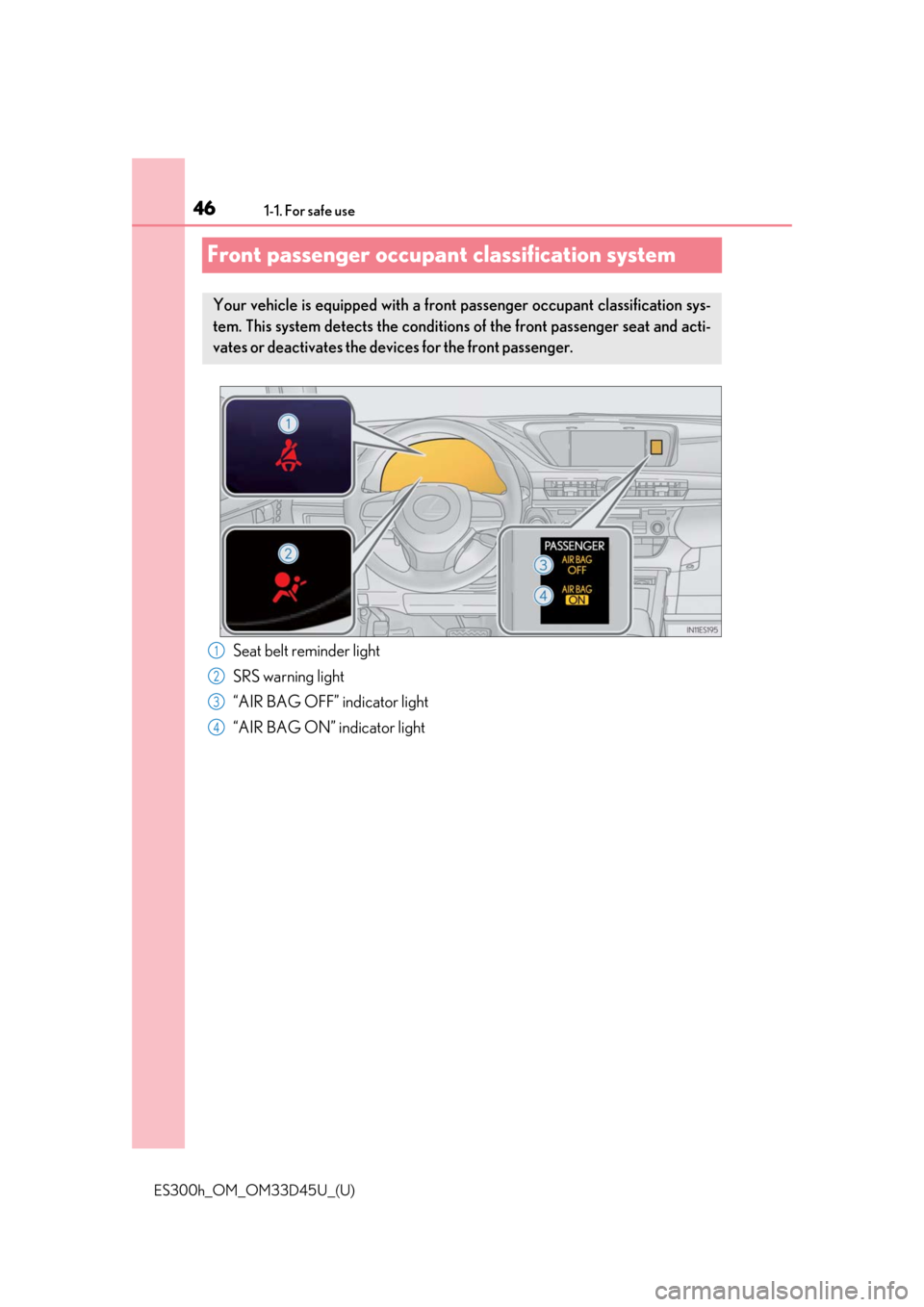
461-1. For safe use
ES300h_OM_OM33D45U_(U)
Front passenger occupant classification system
Your vehicle is equipped with a front passenger occupant classification sys-
tem. This system detects the conditions of the front passenger seat and acti-
vates or deactivates the devices for the front passenger.
Seat belt reminder light
SRS warning light
“AIR BAG OFF” indicator light
“AIR BAG ON” indicator light1
2
3
4
Page 47 of 608
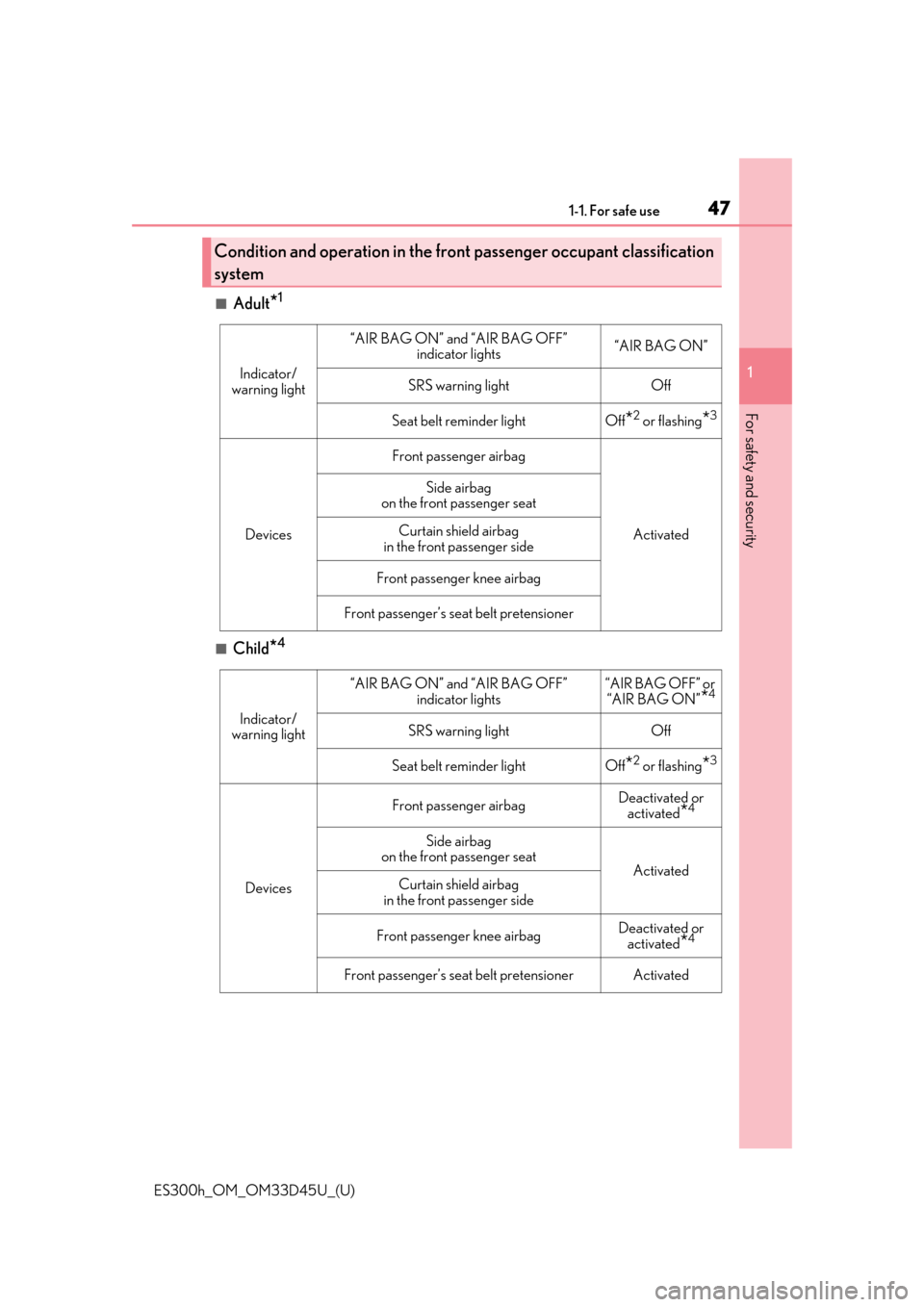
471-1. For safe use
ES300h_OM_OM33D45U_(U)
1
For safety and security
■Adult*1
■Child*4
Condition and operation in the front passenger occupant classification
system
Indicator/
warning light
“AIR BAG ON” and “AIR BAG OFF” indicator lights“AIR BAG ON”
SRS warning lightOff
Seat belt reminder lightOff*2 or flashing*3
Devices
Front passenger airbag
Activated
Side airbag
on the front passenger seat
Curtain shield airbag
in the front passenger side
Front passenger knee airbag
Front passenger’s seat belt pretensioner
Indicator/
warning light
“AIR BAG ON” and “AIR BAG OFF” indicator lights“AIR BAG OFF” or “AIR BAG ON”
*4
SRS warning lightOff
Seat belt reminder lightOff*2 or flashing*3
Devices
Front passenger airbagDeactivated or activated
*4
Side airbag
on the front passenger seat
ActivatedCurtain shield airbag
in the front passenger side
Front passenger knee airbagDeactivated or activated
*4
Front passenger’s seat belt pretensionerActivated
Page 48 of 608
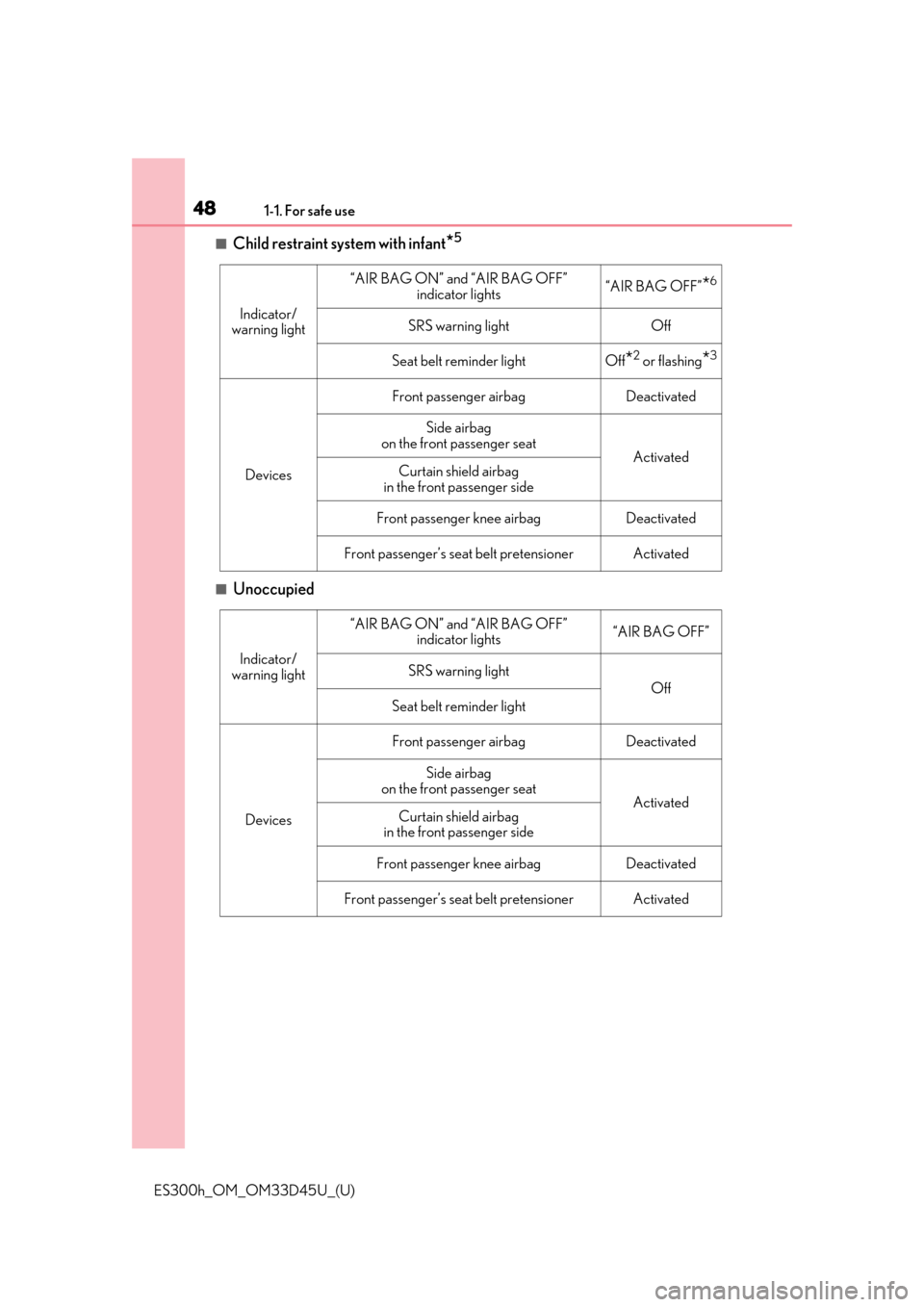
481-1. For safe use
ES300h_OM_OM33D45U_(U)
■Child restraint system with infant*5
■Unoccupied
Indicator/
warning light
“AIR BAG ON” and “AIR BAG OFF” indicator lights“AIR BAG OFF”*6
SRS warning lightOff
Seat belt reminder lightOff*2 or flashing*3
Devices
Front passenger airbagDeactivated
Side airbag
on the front passenger seat
ActivatedCurtain shield airbag
in the front passenger side
Front passenger knee airbagDeactivated
Front passenger’s seat belt pretensionerActivated
Indicator/
warning light
“AIR BAG ON” and “AIR BAG OFF” indicator lights“AIR BAG OFF”
SRS warning light
Off
Seat belt reminder light
Devices
Front passenger airbagDeactivated
Side airbag
on the front passenger seat
ActivatedCurtain shield airbag
in the front passenger side
Front passenger knee airbagDeactivated
Front passenger’s seat belt pretensionerActivated
Page 49 of 608
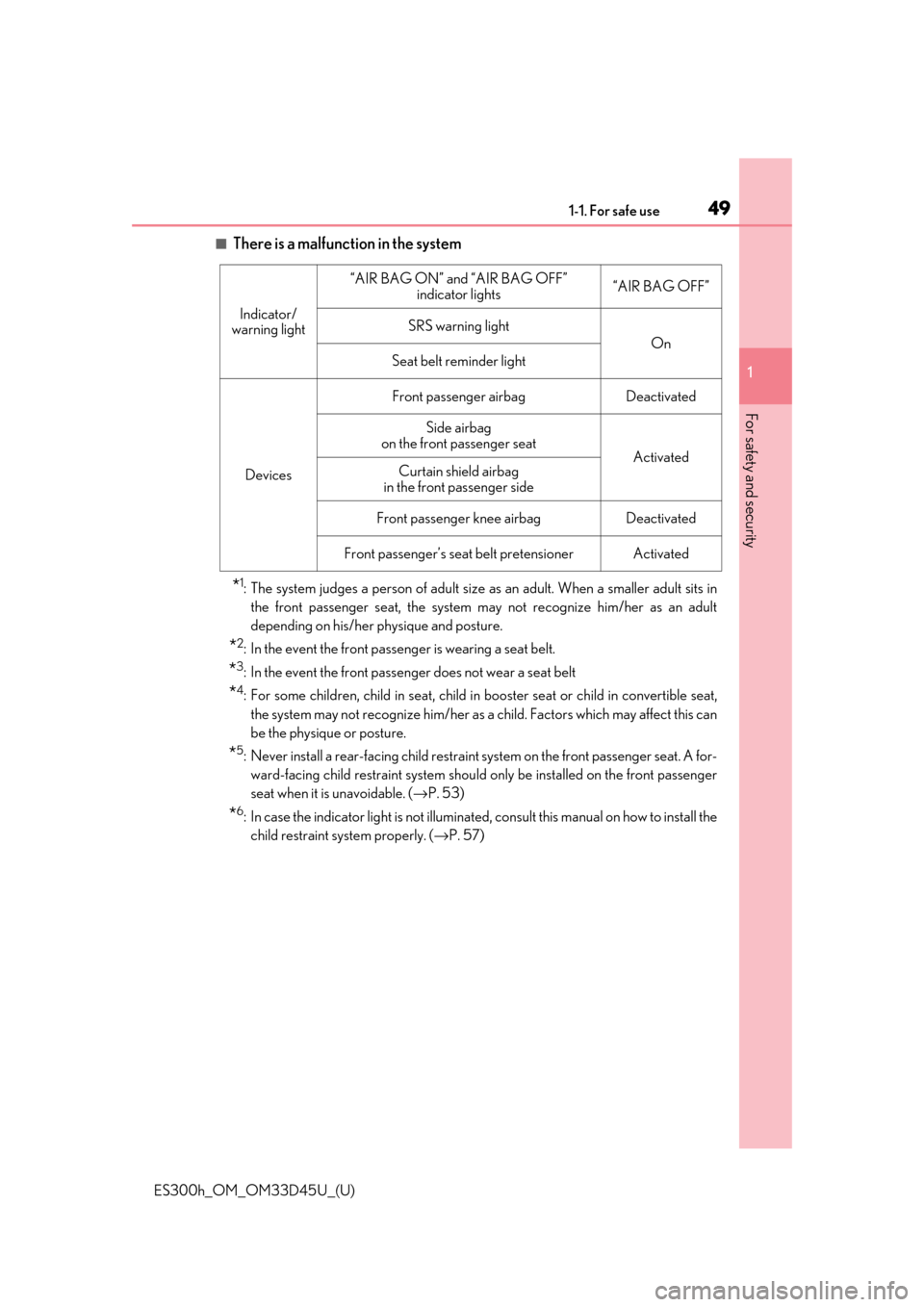
491-1. For safe use
ES300h_OM_OM33D45U_(U)
1
For safety and security
■There is a malfunction in the system
*1: The system judges a person of adult size as an adult. When a smaller adult sits in
the front passenger seat, the system ma y not recognize him/her as an adult
depending on his/her physique and posture.
*2: In the event the front passenger is wearing a seat belt.
*3: In the event the front passenger does not wear a seat belt
*4: For some children, child in seat, child in booster seat or child in convertible seat,
the system may not recognize him/her as a child. Factors which may affect this can
be the physique or posture.
*5: Never install a rear-facing child restraint system on the front passenger seat. A for-
ward-facing child restraint sy stem should only be installed on the front passenger
seat when it is unavoidable. (→ P. 53)
*6: In case the indicator light is not illuminated, consult this manual on how to install the
child restraint system properly. ( →P. 57)
Indicator/
warning light
“AIR BAG ON” and “AIR BAG OFF” indicator lights“AIR BAG OFF”
SRS warning light
On
Seat belt reminder light
Devices
Front passenger airbagDeactivated
Side airbag
on the front passenger seat
ActivatedCurtain shield airbag
in the front passenger side
Front passenger knee airbagDeactivated
Front passenger’s seat belt pretensionerActivated